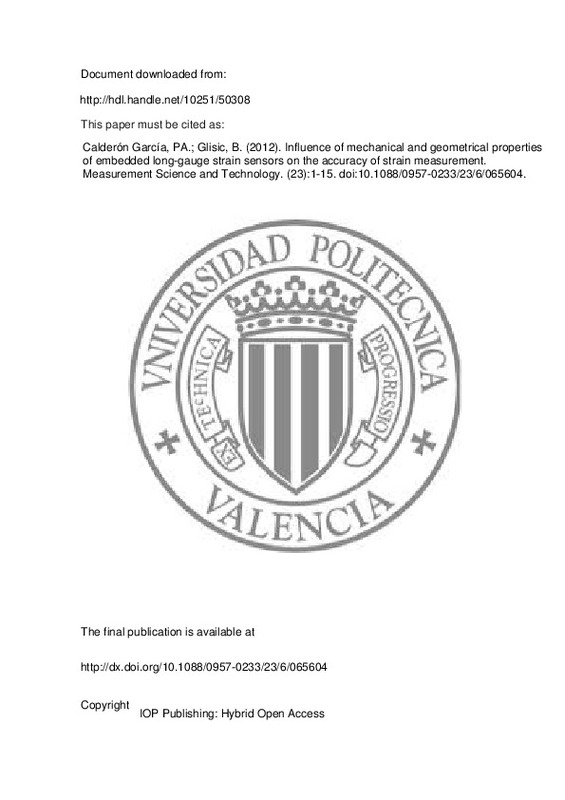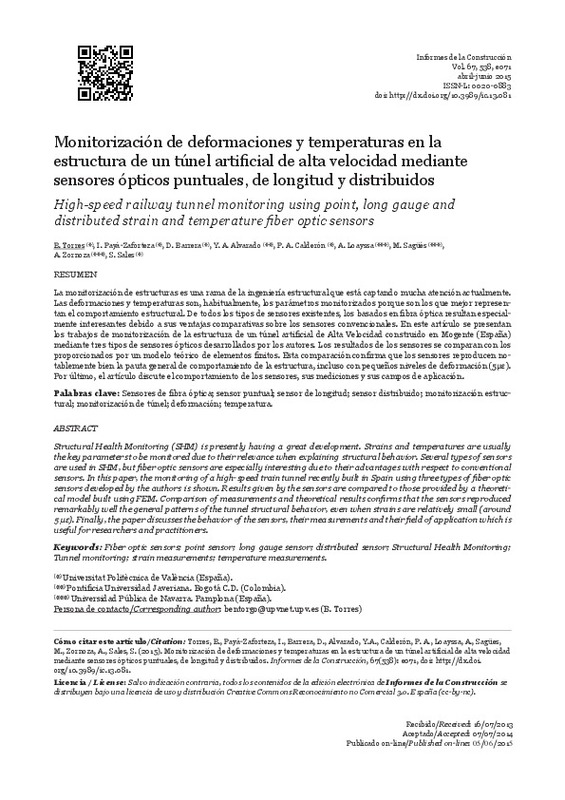Glišić, B., & Inaudi, D. (2007). Fibre Optic Methods for Structural Health Monitoring. doi:10.1002/9780470517819
Ansari, F. (2007). Practical Implementation of Optical Fiber Sensors in Civil Structural Health Monitoring. Journal of Intelligent Material Systems and Structures, 18(8), 879-889. doi:10.1177/1045389x06075760
Li, H.-N., Zhou, G.-D., Ren, L., & Li, D.-S. (2009). Strain Transfer Coefficient Analyses for Embedded Fiber Bragg Grating Sensors in Different Host Materials. Journal of Engineering Mechanics, 135(12), 1343-1353. doi:10.1061/(asce)0733-9399(2009)135:12(1343)
[+]
Glišić, B., & Inaudi, D. (2007). Fibre Optic Methods for Structural Health Monitoring. doi:10.1002/9780470517819
Ansari, F. (2007). Practical Implementation of Optical Fiber Sensors in Civil Structural Health Monitoring. Journal of Intelligent Material Systems and Structures, 18(8), 879-889. doi:10.1177/1045389x06075760
Li, H.-N., Zhou, G.-D., Ren, L., & Li, D.-S. (2009). Strain Transfer Coefficient Analyses for Embedded Fiber Bragg Grating Sensors in Different Host Materials. Journal of Engineering Mechanics, 135(12), 1343-1353. doi:10.1061/(asce)0733-9399(2009)135:12(1343)
Torres, B., Payá-Zaforteza, I., Calderón, P. A., & Adam, J. M. (2011). Analysis of the strain transfer in a new FBG sensor for Structural Health Monitoring. Engineering Structures, 33(2), 539-548. doi:10.1016/j.engstruct.2010.11.012
Kesavan, K., Ravisankar, K., Parivallal, S., Sreeshylam, P., & Sridhar, S. (2010). Experimental studies on fiber optic sensors embedded in concrete. Measurement, 43(2), 157-163. doi:10.1016/j.measurement.2009.08.010
Azenha, M., Faria, R., & Ferreira, D. (2009). Identification of early-age concrete temperatures and strains: Monitoring and numerical simulation. Cement and Concrete Composites, 31(6), 369-378. doi:10.1016/j.cemconcomp.2009.03.004
Glisic, B. (2011). Influence of the gauge length on the accuracy of long-gauge sensors employed in monitoring of prismatic beams. Measurement Science and Technology, 22(3), 035206. doi:10.1088/0957-0233/22/3/035206
Leng, J. S., Winter, D., Barnes, R. A., Mays, G. C., & Fernando, G. F. (2006). Structural health monitoring of concrete cylinders using protected fibre optic sensors. Smart Materials and Structures, 15(2), 302-308. doi:10.1088/0964-1726/15/2/009
Calderón, P. A., Adam, J. M., Ivorra, S., Pallarés, F. J., & Giménez, E. (2009). Design strength of axially loaded RC columns strengthened by steel caging. Materials & Design, 30(10), 4069-4080. doi:10.1016/j.matdes.2009.05.014
Adam, J. M., Ivorra, S., Pallarés, F. J., Giménez, E., & Calderón, P. A. (2009). Axially loaded RC columns strengthened by steel caging. Finite element modelling. Construction and Building Materials, 23(6), 2265-2276. doi:10.1016/j.conbuildmat.2008.11.014
Adam, J. M., Ivorra, S., Pallares, F. J., Jiménez, E., & Calderón, P. A. (2008). Column–joint assembly in RC columns strengthened by steel caging. Proceedings of the Institution of Civil Engineers - Structures and Buildings, 161(6), 337-348. doi:10.1680/stbu.2008.161.6.337
Adam, J. M., Ivorra, S., Pallares, F. J., Giménez, E., & Calderón, P. A. (2009). Axially loaded RC columns strengthened by steel cages. Proceedings of the Institution of Civil Engineers - Structures and Buildings, 162(3), 199-208. doi:10.1680/stbu.2009.162.3.199
Johansson, M., & Gylltoft, K. (2001). Structural behavior of slender circular steel-concrete composite columns under various means of load application. Steel and Composite Structures, 1(4), 393-410. doi:10.12989/scs.2001.1.4.393
Johansson, M., & Gylltoft, K. (2002). Mechanical Behavior of Circular Steel–Concrete Composite Stub Columns. Journal of Structural Engineering, 128(8), 1073-1081. doi:10.1061/(asce)0733-9445(2002)128:8(1073)
[-]







![[Cerrado]](/themes/UPV/images/candado.png)



